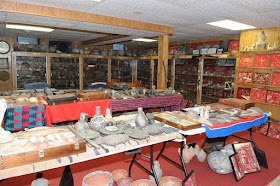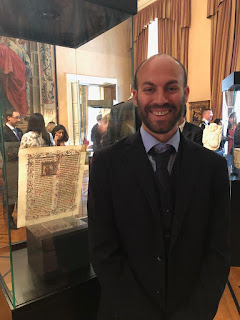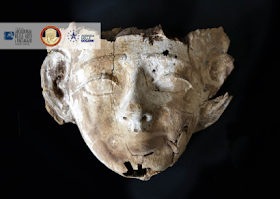By Edgar Tijhuis
This year, the ARCA Postgraduate Program in Art Crime and Cultural Heritage Protection will be held from May 30 through August 14, 2019 in the beautiful heart of Umbria in Amelia, Italy. In the months leading up to the start of the program, this year’s professors will be interviewed. In this one, I am speaking with Arthur Tompkins from New Zealand, a judge and specialist on art crimes during war.
Can you tell us something about your background and work?
Certainly! I am a Judge in New Zealand, based in Wellington. In my day job I try both criminal and civil cases, plus I sit on the NZ Parole Board. I have been a judge for over 20 years now, and I still enjoy my job. I like the variety, the unexpectedness of each day, and the interaction with the whole cross-section of the community I serve.
I have been coming to teach Art in War, at Amelia, since 2010. I first visited in 2009, when the first ARCA program was underway, to present at the
Art Crime Conference, Noah Charney asked me to come back the next year to teach my course, and the rest is history...
What do you feel is the most relevant part of your course?
I like to think that over the five days of my course - first the historical survey when we cover 25 centuries of armed conflict, from the Classical World through to Iraq and Syria, and many conflicts in between, and then the response of the international and private legal systems to what has occurred - discerning the common features of the arc of art crime in war are very relevant. The ways in which, during war, art is displaced, lost, destroyed, stolen, and sometimes saved, vary enormously in their individual circumstances, but underlying the variety is the sameness of it: the intensely symbolic way in which art is viewed by combatants, who seek to use (or destroy) art to serve their wider purpose. So, despite the variation of circumstances, there are common features which happen over and over again - hence the need to learn the lessons of history, and to protect the art anew in the face of every new conflict.
What do you hope participants will get out of your course?
I hope that by the end of the course the participants will have an appreciation both of the wide sweep of human history, as manifested by humankind's many conflicts, and against that backdrop the way that humankind's great art has been fought over, pursued, made vulnerable, and (perhaps not as often as we would like) made secure so that it survives the tempest swirling around it. And I hope that, when faced with the outbreak of a new conflict, thy will come to realise that the inevitable threat to the art caught up by the red-hot rake of the battle-line is not new, that there are valuable lessons to be learned from past mistakes, and that the art can, with effort and determination and will, be protected despite the clash of arms surrounding it.
What would a typical day be like in your classroom?
We gather in the lecture hall at the start time of the day, usually with copious bottles of water and perhaps a coffee or two, and embark on a close look at whatever part of human history we have reached that day. This will usually be done via illustrated lectures from me, interspersed with short student presentations about a number of the major art works we encounter during the day. A week or so before my class starts, I ask each participant to sign up to talk to the class about one or two artworks that we will touch on or discuss during the course. Sometimes the participants will already know about the work, perhaps they have seen it, or have some personal connection to it, other times they will come to it completely fresh. Their presentations usually summarise the history of the work and the artist, perhaps talking a bit about the place the work has in the artist's oeuvre, and what happened to it during the war that engulfed it.
We have five hours of class time each day, with that being broken up by coffee (or gelato) breaks, and a long lunch break in the heat of the middle of the day. So, although it is an intense few days, we enjoy frequent time out to recharge!
During the course, each participant completes a short essay, on some aspect of art crime during war. The last part of the course is then taken up with individual students giving slightly longer presentations to the class when they talk about the essay they submitted, the art work or works, the fate of the works during war, the story of their survival, or whatever it might be. I am constantly fascinated by the wide variety of subjects they come up with each year, to research and write about.
While each year participants are very enthusiastic about your course, is there anything you learn from them in class?
The most valuable thing is that I learn to look at art with new eyes, especially during the participant presentations. Often these will cover aspects of art crime during war that we do not have time to cover in class, or only touch upon very briefly. I learn a lot during these presentations, and come away with a fresh respect for the research skills and breadth of experience of ARCA's attendees!
In anticipation of your courses, what book, article, or movie would you recommend to participants?

There have been two high-profile movies in the last few years which have been based squarely on the fate of art in war. Both are worth watching before taking my course, but for different reasons. George Clooney's Monuments Men got most of the art right, but a lot of the rest of the always fascinating story of the Monuments Men (and Women) mostly wrong. Helen Mirren's Woman in Gold did much better - getting both the art, and the surrounding tragedy of the very human story of the painting's fate (within the inevitable constraints of a two hour movie), right.
What makes the yearly ARCA program so unique?
There are a number of aspects, I think, that make the ARCA course unique. First, the setting - the wonderful ancient town of Amelia, slightly isolated because of the absence of a railway station, is the perfect setting for a summer programme - small enough to get to know very quickly, but with a labyrinthine Old Town that constantly surprising no matter how often you have walked its twisting and turning streets and alleys and tunnels and stairs. There is always something fresh and surprising around the next corner! The town has a rhythm to its daily life that quickly propels both those involved in the ARCA program into the centre of Italian town life - the casual friendliness of the locals, the evening passeggiata, the always-open (or so its seems) cafes and bars that are so central to the community's life, and the beauty of the ancient surroundings.
Then there is the multidisciplinary faculty, drawn from a very wide spectrum of disciplines and areas of expertise, who bring decades of experience and wisdom to their respective courses.
And finally there is the distilling of what, in any other setting, might be a year or more of classes, into an intense and concentrated period of time spent in Amelia - where everyone in the course is there because they really want to be there, sharing a common fascination with art and the crimes committed against it, and where everyone you meet is happy to share and to learn.
Which other course in the program would you love to follow yourself and why?
Personally, I would be fascinated by the Museum Security course - one of the by-products of teaching art crime is that you can't just visit a museum or a gallery or an exhibition without thinking about what might happen if someone else took it into their heads to commit a crime against the art you are enjoying - a theft or an attack or some other misguided venture. So I often wonder about the unseen protections that (I hope) carefully guard the art work...and the striking of the difficult balance between accessibility - making the art open and accessible and able to be enjoyed by many visitors - and protection, which often means compelling visitors to step back and not enjoy the up-close-and-personal experience of the art that might otherwise be possible, is a dynamic and ever-changing challenge that I would love to know more about.
Is there anything you can recommend for future participants to do in Amelia or Umbria?
Learn at least some rudimentary Italian before you arrive, enough to say hello and good morning and good evening, and to order coffee and gelato and pizza! And use that to get to know some of the locals, and experience something of their lives. I now have friends who live in Amelia, and catching up with them is one of the annual joys of my visits back to Amelia.
 |
Judge Arthur Tompkins' writing on the
Four Horses of the Basilica of San Marco
made its way into Dan Brown's bestseller, Inferno. |
Are there any funny or interesting things you experienced in Italy, outside class?
The Italian railway system is a constant source of enjoyment, frustration, annoyance, wonder and humour, that almost never disappoints!
And a visit to Venice, whilst we still can, is high on my list of recommendations - it is such an irrational and unexpected place, that should not exist, but defiantly does, and it hides a multitude of joys. Not the least of which are the Four Horses of the Basilica of San Marco, the artwork with the longest history of crimes being committed against them (roughly 2500 years, give or take a few centuries). Come take my course to learn their fascinating story! Venice was also the home of the largest stolen painting on public display anywhere in the world - Veronese's Wedding at Cana, taken from the refectory of the Benedictine monastery on the island of San Giorgio Maggiore by Napoleon, transported to the Louvre (after being cut into several pieces), and hung there, up until recently, opposite the Mona Lisa, where it used to get overlooked by thousands every day!
What is your experience with the yearly ARCA conference in June?
I can't always get to the conference, but when I do the sheer breadth of experience and knowledge on display year after year is wonderful - ARCA does a great job of gathering together the foremost specialists in the fight against art crime from around the world, and provides a forum for both specialist presentations, and the free exchange of information, of views, of contacts, and renewing and making friendships. And because the conference is based in Amelia, the warmth of the welcome from the town is an added highlight - and introducing newcomers to the joys of Amelia, and discovering new joys in the process, is always memorable!
For a detailed prospectus and application materials or for general questions about this postgraduate program please contact us at education@artcrimeresearch.org
Edgar Tijhuis serves as the Academic Director at ARCA and is a visiting scholar at the Institute of Criminology in Ljubljana. He is responsible for the postgraduate certificate program in the study of art crime and cultural heritage protection and since 2009, has taught criminology modules within the ARCA program.






































